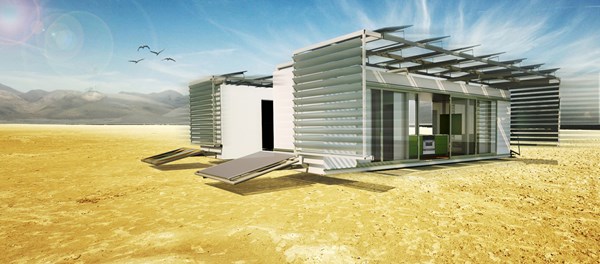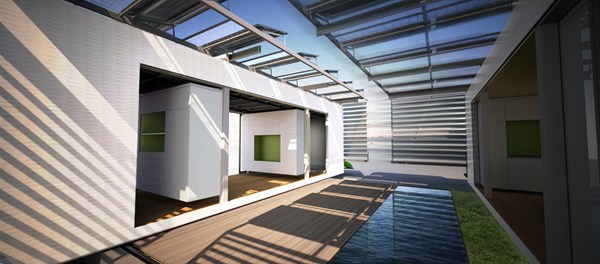LOS ANGELES, May 30, 2013 (GLOBE NEWSWIRE) -- A team of architecture students from the Southern California Institute of Architecture (SCI-Arc) and engineering students from California Institute of Technology (Caltech) are building a one-of-its-kind, solar-powered net-zero home that will enable residents to change the configuration of their living environment based on preference, presenting homeowners with a house uniquely suited for their needs. Currently being built on the SCI-Arc campus in the heart of downtown Los Angeles, DALE, which stands for Dynamic Augmented Living Environment, proposes a completely new approach to sustainability and includes many other engineering and design breakthroughs that ensure its energy usage is optimized.
At 600 square feet, DALE is a micro house with an unprecedented flexible interior allowing it to transform into a home three times its size, demonstrating not only size variability, but also breakthrough advances in programmatic flexibility. Its two independent modules sit on a rail system that provides the option to expand and contract the home in order to react to climate changes, as well as take into account lifestyle needs. When the modules are spaced apart, a mid-yard is created that expands the living space and allows occupants to take advantage of California's sublime climate. DALE's sliding overhangs allow for additional configurations providing shading and privacy where needed. When an expansive living space is not needed, or when the night climate becomes cold, DALE's modules come together, seal and require minimal energy to power the home, maximizing efficiency with a small footprint. The home also produces more energy than it consumes, so that it can exist off the grid.
By moving along its rail system and opening up to nature, DALE expands into the environment, being at the same time small and spacious, and efficient and expansive. Its range of motion for the competition prototype is 54 feet, meaning the home's square footage can grow from 600 to nearly 1,800 feet. In the real world, beyond the decathlon competition, the home can exist either on a standard suburban lot, or on a large expanse of land where the system can, in theory, be added to, resulting in much more variation.
Students are also implementing upgraded energy monitoring and tracking features that will make it intuitive for a homeowner to manage their energy and water usage. Due to DALE's transformative ability, great attention was dedicated to the remarkable safety system, giving the homeowner peace of mind when the modules are moving.
This unique home is being developed for the Solar Decathlon 2013, an international competition sponsored by the United States Department of Energy. The competition will for the first time take place in California, at the Orange County Great Park in Irvine, where it will culminate in a Solar Village open to the public from October 3-13.
Construction of DALE kicked off in March with the pouring of the home's foundation in SCI-Arc's parking lot, followed by the craning of the two modules' steel frames. It will continue through the summer, wrapping up in late August to allow ample time for system testing. During the past 2012-2013 school year, team members have been researching the climate conditions at the Irvine Great Park and have designed DALE's system to meet the demands of the Solar Decathlon's five measured contests. The team is also applying the lessons learned from SCI-Arc and Caltech's previous participation in the 2011 edition of the decathlon, when the CHIP (Compact Hyper-Insulated Prototype) solar house designed by a joint team from the two schools placed 6th overall in the contest with top 3 finishes in five of the ten performance categories.
The Solar Decathlon is a unique program that is student driven: students design, build, engineer and fundraise for the project. Expert support is provided through working closely with corporate partners to ensure the project's success. Some examples of such mentorship are the architectural students collaborating with structural engineers at Buro Happold to ensure the house is structurally sound, and the engineering students meeting with logic controller specialists, the CTO of Control4, and a member of JPL's Space Architecture team. Through the completion of the project, students will work closely with Southern California Edison's emerging technologies program to gain a better understanding of DALE's performance and how it can benefit the general public.
Download images at: www.sciarc.edu/decathlon/PressKit.zip.
About the Solar Decathlon
The Solar Decathlon competition is a biennial event sponsored by the U.S. Department of Energy in which university teams put forward proposals for the design of net-zero-energy solar powered homes. Twenty teams from around the world are selected to take part and are tasked with designing and building a green home. The competition culminates in the Solar Village, which will be on the runways of the Orange County Great Park in October 2013, with public tours and a number of tasks that simulate the energy and water usage of a family living in the homes. The Solar Decathlon challenges teams to design, build and operate solar-powered houses that are cost- effective, energy-efficient and attractive. The winner of the competition is the team that best blends affordability, consumer appeal and design excellence with optimal energy production and maximum efficiency. Open to the public and free of charge, the Solar Decathlon enables visitors to tour the houses, gather ideas to use in their own homes, and learn how energy-saving features can help them save money today.
About the Resnick Sustainability Institute at Caltech
The Resnick Sustainability Institute is Caltech's studio focused on the breakthroughs that will enable global sustainability. It marries bold creativity and deep scientific knowledge by encouraging original thinking and diversity of ideas. The Resnick Sustainability Institute works with some of the world's top and emerging scientists and engineers—at the California Institute of Technology and beyond. Learn more at http://resnick.caltech.edu.
About SCI-Arc
Southern California Institute of Architecture (SCI-Arc) is dedicated to educating architects who will imagine and shape the future. It is an independent, accredited degree-granting institution offering undergraduate and graduate programs in architecture. Located in a quarter-mile-long former freight depot in the Arts District in Downtown Los Angeles, the school is distinguished by its vibrant studio culture and emphasis on process. SCI-Arc's approximately 500 students and 80 faculty members, most of whom are practicing architects, work together to re-examine assumptions, create, explore and test the limits of architecture. SCI-Arc is ranked 1st in computer applications and 2nd in design in the 2013 America's Best Architecture Schools survey from DesignIntelligence, and #1 graduate and undergraduate architecture school in Western U.S. www.sciarc.edu
Photos accompanying this release are available at:

